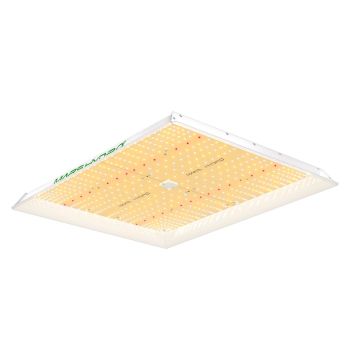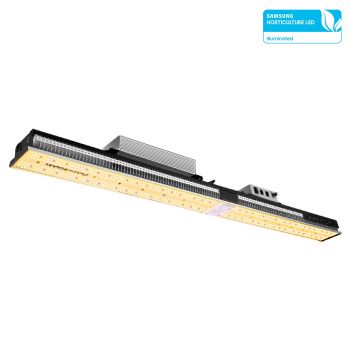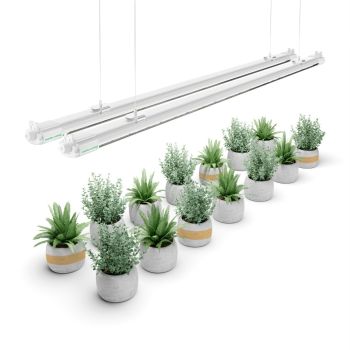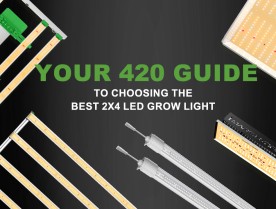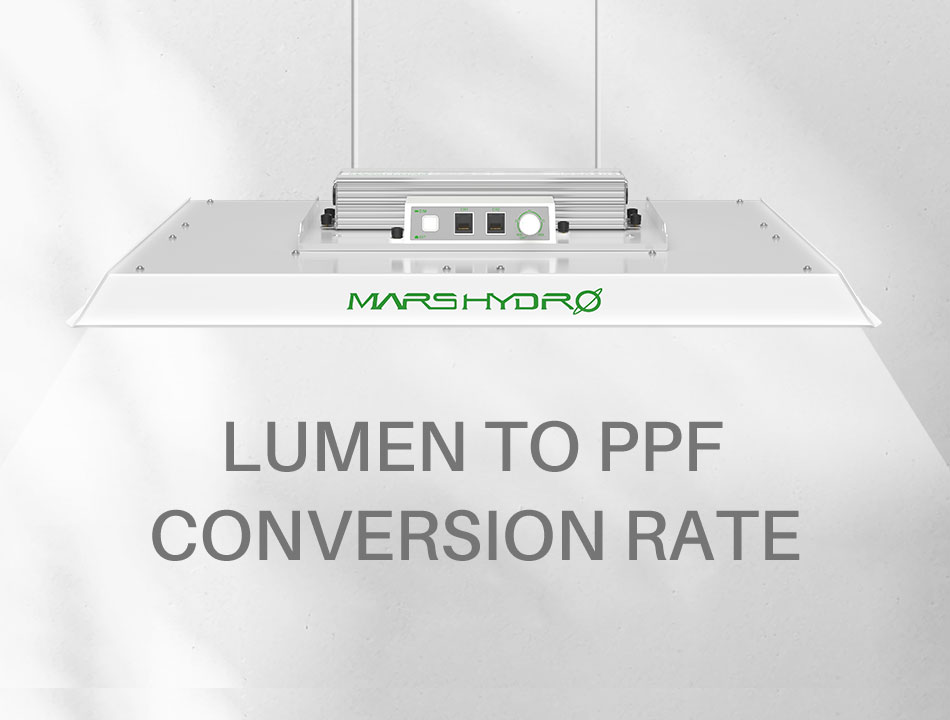
In gardening, it is crucial to understand the relationship between light and plant growth. When measuring the intensity of light, two commonly mentioned terms are lumen and PPF (Photosynthetic Photon Flux). While PPF is now widely recognized as the best way to measure the quantity of light in plant-centric wavelengths (PAR), lumen used to be widely used in plant cultivation as well. Some growers may still rely on a lumen meter or lux meter for their growth plans, but the entire industry now presents lighting data in PPF. Therefore, Mars Hydro, catering to our customers' needs, will introduce and provide instructions on how to convert lumens to PPF specifically for Mars Hydro LED grow lights in this blog.
Understanding Lumen and PPF
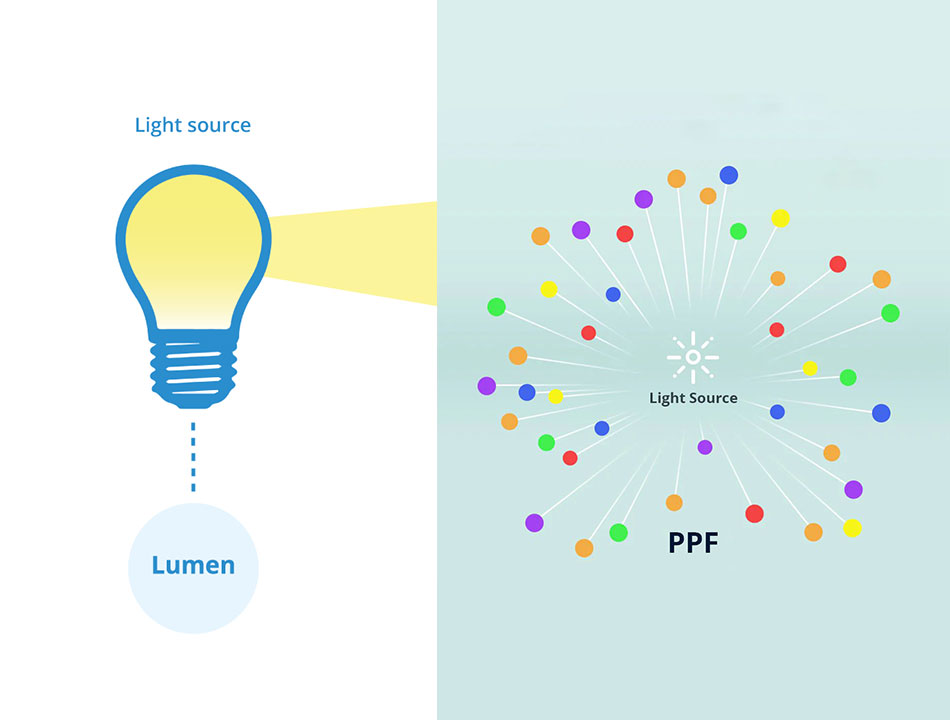
What is a Lumen?
Lumen is a unit of measurement that quantifies the total amount of visible light emitted by a light source. It considers the sensitivity of the human eye to different wavelengths of light. For lighting purposes, lumen indicates the brightness or visual perception of light. Lumens are the best measurement to use when evaluating how well a light will illuminate an area for human eyes. However, it does not provide specific information about the light's effectiveness for photosynthesis.
What is a PPF?
PPF, or Photosynthetic Photon Flux, is a metric that measures the number of photons in the photosynthetically active wavelength range (400-700 nm) emitted by a light source per second. PPF quantifies the light available for photosynthesis and directly affects plant growth, development, and overall yield.
Importance of PPF in Horticulture
In horticultural applications such as indoor gardening or greenhouse cultivation, PPF is crucial for selecting appropriate lighting systems and optimizing plant growth. By measuring PPF, growers can ensure that plants receive the optimal amount of light required for photosynthesis and avoid underexposure or overexposure, which can have adverse effects on plant health and productivity.
The Difference Between Lumen and PPF
Lumen and PPF (Photosynthetic Photon Flux) are both terms used to measure light, but they differ in their focus and purpose.
Lumen is a unit of measurement that quantifies the total amount of visible light perceived by the human eye. It takes into account the sensitivity of the human eye to different wavelengths of light. Lumen is commonly used in general lighting applications to evaluate the brightness of light sources such as bulbs or fixtures. However, lumen does not consider the specific wavelengths of light that are crucial for plant growth and photosynthesis.
On the other hand, PPF is a measurement specifically designed for plants. It quantifies the total amount of light in the range of wavelengths (known as photosynthetically active radiation or PAR) that plants use for photosynthesis. PPF focuses on the light energy that is essential for plant growth, flowering, and fruiting. PPF is measured in units of micromoles per second (μmol/s), reflecting the number of photons in the PAR range emitted by a light source per second.
In summary, while lumen measures the total visible light for human perception, PPF measures the quantity of light in the specific wavelengths that are critical for plant photosynthesis. PPF is considered a more accurate and relevant metric when evaluating lighting for horticultural purposes.

Can Lumen be Converted to PPF?
No, lumen cannot be directly converted into PPF. But, it may be possible in some cases.
The lumen measurement takes into account the sensitivity curve of the human eye. For instance, green light, particularly at a wavelength of 555nm, appears the brightest to human eyes, resulting in a higher lumen value than the same amount of other light. Therefore, light sources that emit a higher proportion of green light will have a higher lumen rating, even if the light does not contain an optimal balance of wavelengths for plant growth and photosynthesis. In contrast, PPF does not measure how bright or visible they are to the human eye.
But, this conversion is possible if you know the detailed spectral characteristics of the light source, or in the case of monochromatic light, where only a single wavelength is involved. That is to say, While there is no universal conversion rule that applies to all situations, it is still possible to convert lumens to PPF when specific information about the light source is available. For instance, if you have precise knowledge about a particular light source (with a fixed spectrum), such as the Mars Hydro TS1000, and you want to determine its lumen to PPF conversion rate, the conversion can be achieved. This requires understanding the detailed spectral properties and characteristics of the TS1000.
Lumen to PPF Conversion Rate of Mars Hydro LED Grow Lights
To assist our valued customers in navigating this transition, Mars Hydro has delved into the conversion from lumens to PPF specifically for our LED grow lights. We listed the conversion rate below and explains how to use it.
It's important to note that this rate is roughly calculated and may not yield precise PPF or lumen values. It should be emphasized that this rate is applicable exclusively to Mars Hydro LED grow lights. The conversion rate listed below serves as a reference for growers who require guidance regarding the appropriate lumen levels for their plants when adjusting the dimming settings on Mars Hydro lights. That is, you turn the TS1000 up to 25% brightness, you measure the lumens it now puts out, and want to know what PPF it puts out.
Model | Conversion Rate (Lumen:PPF) | Model | Conversion Rate (Lumen:PPF) | Model | Conversion Rate (Lumen:PPF) | Model | Conversion Rate (Lumen:PPF) |
SP 150 | 64 | TS 600 | 70 | FC 3000 | 64 | FC-E 3000 | 66 |
SP 3000 | 62 | TS 1000 | 68 | FC 4800 | 64 | FC-E 4800 | 60 |
SP 6500 | 62 | TSW 2000 | 68 | FC 6500 | 65 | FC-E 6500 | 63 |
VG80 | 69 | TSL 2000 | 68 | FC 8000 | 65 | FC-E 8000 | 66 |
TS 3000 | 65 | FC 1000W | 61 | FC-E 1000W | 61 | ||
Then there is a simple formula:
Lumen you test ÷ Conversion Rate = PPF Value you want
For example, if you’re using TS1000 and get a lumen value of 18500 lm, then the PPF of the TS1000 now is:
18500 ÷ 68 = 272 μmol/s
By understanding how lumens translate into PPF values specific to Mars Hydro products, growers can make informed decisions when designing and optimizing their indoor cultivation environments.
Factors Affecting Conversion Accuracy

While converting lumen to PPF, it's essential to consider various factors that can impact the accuracy of the conversion.
Spectral Distribution
The spectral distribution of a light source plays a significant role in plant growth and photosynthesis. It influences the conversion factor and affects the conversion accuracy. Spectral distribution data helps determine the amount of photosynthetically active photons emitted.
Angle of Light Distribution
The angle at which light is distributed affects the intensity of light received by plants, especially when LEDs only provide a fixed angle of light emission with few disperse. It influences the PPF values and should be considered when converting lumen to PPF for accurate measurements.
Light Loss Factors
Light can experience losses due to factors such as reflection, absorption, and transmission. These losses affect the actual PPF received by plants and can impact the accuracy of the conversion.
Inaccuracy of Lumen Meters
All test meters on the market have a tolerance between the test data and the real data, resulting in inaccurate conversions, especially when the rate is also roughly calculated.
Therefore, consider wisely the value of the PPF you get in this way. Again, this is just a reference for those customers who only want a rough idea of their lighting setup. If you want a more accurate number, investing in a PAR meter or PBAR meter is the best way to go.
Call-Back FAQs

Q: Can I convert PPF back to Lumen?
A: Using the conversion rate we provide in this blog is possible to convert PPF back to Lumen. However, while it is possible to estimate lumen values based on PPF, the accuracy of the conversion depends on factors such as the light source's spectral distribution. It is generally more reliable to measure the lumen directly or use lumen values provided by the manufacturer.
Q: Can I use a lumen-to-PPF conversion for any light source?
A: Lumen-to-PPF conversion factors are specific to different light source technologies. It is important to use the appropriate conversion factor for the specific light source being used to ensure accurate measurements.
Q: Is there a standard conversion factor for all light sources?
A: No, conversion factors vary depending on the light source technology. Different light source technologies, such as HID lamps, fluorescent lamps, and LEDs, have different efficiencies in converting energy to photosynthetically active photons, requiring specific conversion factors.
Q: Why is PPF important for indoor gardening?
A: PPF quantifies the amount of light available for photosynthesis, directly influencing plant growth and development. By measuring PPF, indoor gardeners can optimize the light environment and ensure plants receive the ideal amount of light for healthy growth.
Conclusion
We hope this blog can help some growers solve their problems in terms of lumens and PPF. Our aim is to assist growers in overcoming challenges and empower them to enjoy the process of cultivating plants while reaping abundant harvests. Happy growing!


